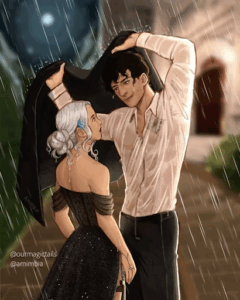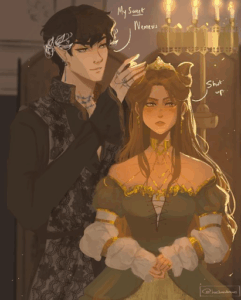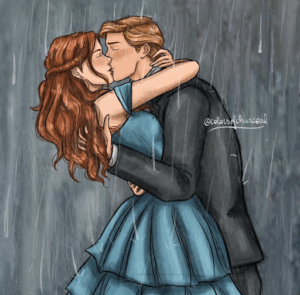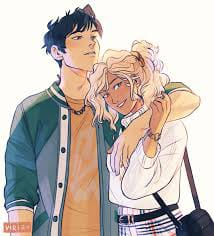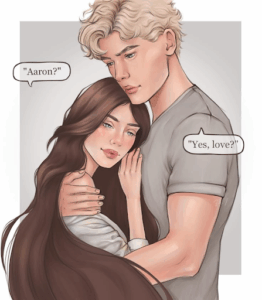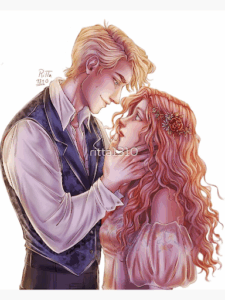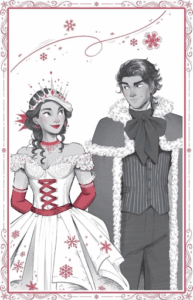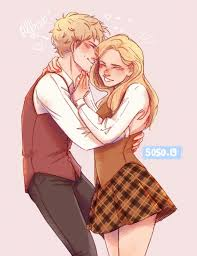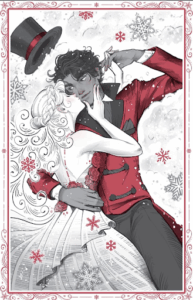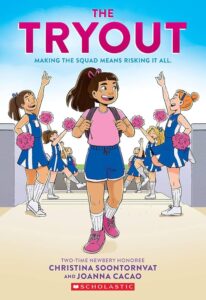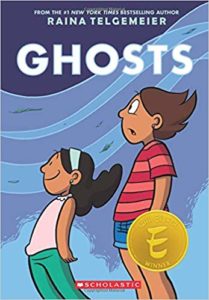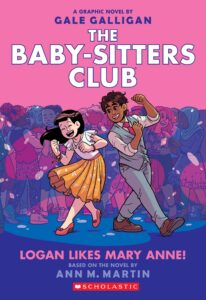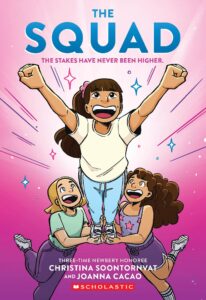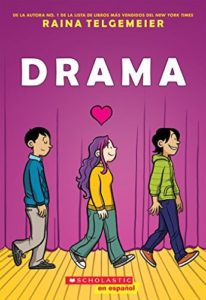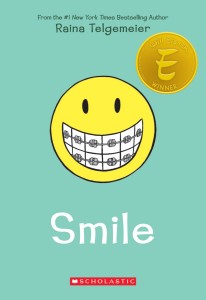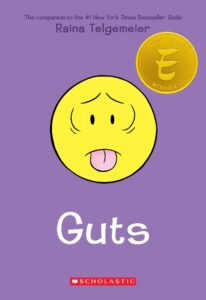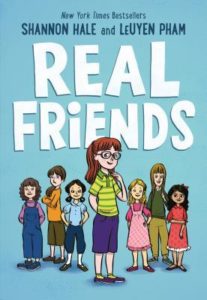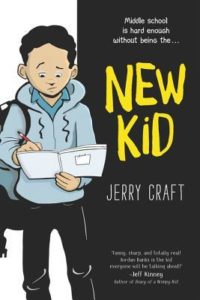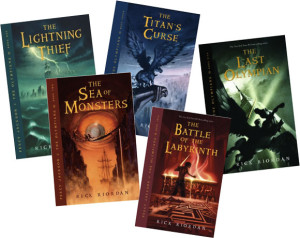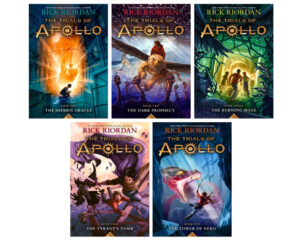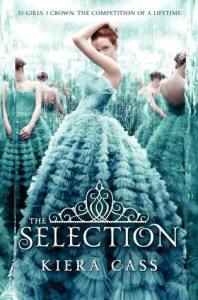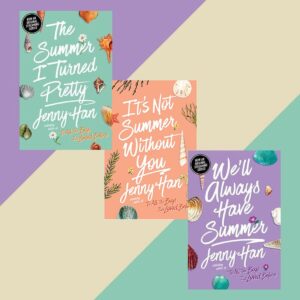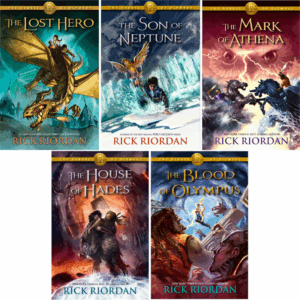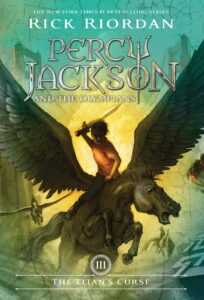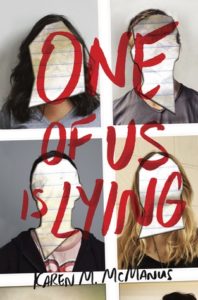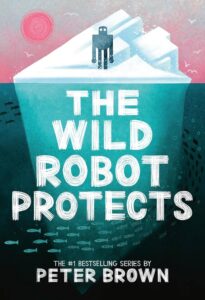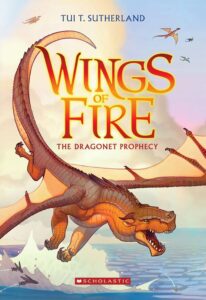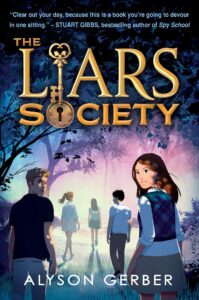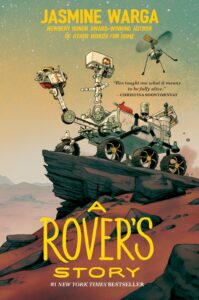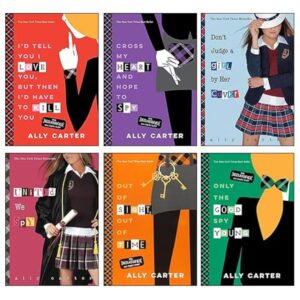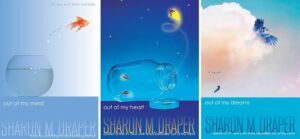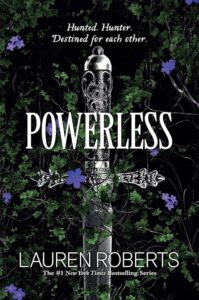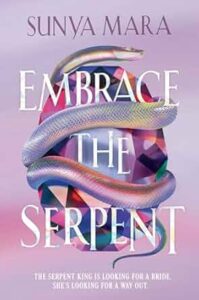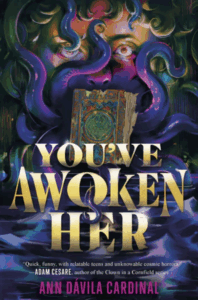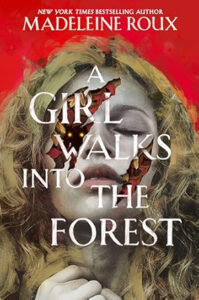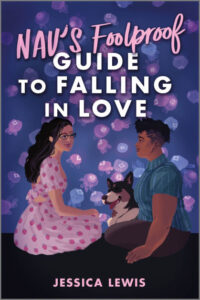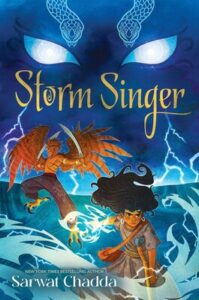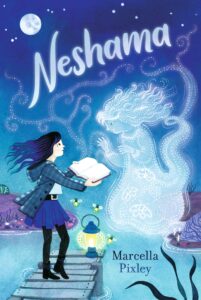Looking at Characters from Favorite Books
“Top Ten Favorite Book Couples” by Omayma H., 8th grade
Romance in books is special. Readers feel connected to characters as they experience love and challenges. Whether it’s enemies to lovers or friends to lovers, here are my top 10 favorite book couples. (Note: These couples are NOT in order. I can’t pick!)
Powerless – Kai and Paedyn
Trope: Enemies to Lovers
Kai and Paedyn come from two different social classes. Kai, the prince and the future Enforcer of Illya, and Paedyn, an illegal ordinary, who lives in the slums. They aren’t supposed to meet, not when Peadyn is supposed to be hiding from Kai and his job as the enforcer to get rid of all ordinaries. But when Kai gets into trouble in the slums, Paedyn saves him without really knowing who he is, and that results in her getting chosen for the purging trials, all because she saved the prince. Now, Kai and Paedyn have to compete in the trials against each other. But instead of becoming rivals and hating each other, they form a relationship of teasing, pretend hatred, and care. They help each other through the trials, slowly falling for each other at the same time. Despite a small problem that happens in their relationship, Kai and Paedyn grow to trust and love each other through the trilogy. Facing challenges to be with each other, but always caring for each other.
The Cruel Prince – Cardan and Jude
Trope: Enemies to Lovers
Fae and mortal, prince and outcast. Carden and Jude were enemies from the beginning, ever since Jude and her sisters were brought to faerie when they were small. Carden, the youngest and meanest of the kings’ children, had always seemed to have something against Jude. Though during the progression of the series, Jude and Carden get closer as they work together and fall in love. Their relationship is filled with heartfelt words, filled with adorable nicknames, confessions, and teasing. Not to mention supporting each other all the time. Their sharp banter hints at a growing attraction. Cardan’s harshness hides sensitivity, while Jude’s strength draws him in. Their journey shows that love can develop even in rivalry.
The Selection – Maxon and America
Trope: Friends to Lovers
Maxon and America’s relationship starts as a friendship. They get to know each other during the Selection competition. America enters the Selection for other reasons, but begins to have real feelings for Maxon. Maxon is kind, understanding, and supportive. America struggles with her feelings and her past. They share sweet moments and face challenges together. They learn to trust each other. Their relationship is built on friendship, respect, and a growing romantic bond as they navigate their world. Both of them face hard challenges, but are always there for each other. Filled with sweet first times and love like no other.
The Inheritance Games – Jameson and Avery
Trope: Friends to Lovers
Jameson and Avery’s relationship begins as a friendship. They work together to solve puzzles and uncover secrets in a game set by Jameson’s grandfather for Avery’s inheritance. As they spend time together, they develop a strong connection and trust. Jameson is protective and supportive of Avery, while she brings out his softer side. Their bond grows as they face challenges, leading to deeper feelings for each other. No matter what challenges they face, both of them stay by each other’s side and help each other no matter what.
Percy Jackson and the Olympians – Percy and Annabeth
Trope: Friends to Lovers
Percy and Annabeth’s relationship begins as a friendship, but it slowly develops into something deeper. They face many adventures and challenges together as demigods, supporting and protecting each other along the way. Their bond is built on trust, loyalty, and mutual respect. They also share a lot of playful banter, which adds a fun dynamic to their connection. Over time, their feelings grow, and they become a strong couple, always there for one another through thick and thin.
Shatter Me – Aaron and Juliette
Trope: Enemies to Lovers
Aaron Warner and Juliette’s relationship is intense and complicated. At first, they are enemies, with Warner being a powerful figure who represents the world Juliette is trying to escape. However, as they spend more time together, they start to understand each other’s struggles. Warner reveals his softer side, showing he cares for her deeply, while Juliette learns to trust him. Their relationship evolves from hatred to a deep emotional connection, filled with passion and support as they face challenges together. At the end, they become a strong couple who help each other heal and grow.
Once Upon a Broken Heart – Jacks and Evangeline
Trope: Enemies to Lovers
Jacks and Evangeline’s relationship starts with them as enemies. Jacks is mysterious and often manipulative, while Evangeline is strong and wants to protect herself and her loved ones. As they spend time together, they begin to understand each other. This leads to unexpected feelings between them. Despite the tension and challenges they face, their connection grows stronger. They learn to trust and care for one another, turning their rivalry into a romantic relationship.
Caraval – Julian and Scarlet
Trope: Enemies to Lovers
Julian and Scarlet have a strong friendship that grows into a romantic relationship. They start by supporting each other and face challenges together. As they spend time together, their trust in each other deepens, and they develop romantic feelings. Throughout their journey, they help each other grow and overcome obstacles. Even though their relationship has some problems like lies and hidden secrets, they learn to trust each other.
Keeper of the Lost Cities – Keefe and Sophie
Trope: Friends to Lovers
Keefe and Sophie are close friends with a complicated relationship. They start as friends and build a strong bond based on trust and support. Keefe is playful and brings fun to their friendship, while Sophie is serious and focused on her tasks. Their differences balance each other. They understand one another and help each other with challenges. As they go on adventures together, their feelings for each other deepen. Overall, their relationship includes friendship, loyalty, and growing emotions. Keefe had feelings for Sophie from the beginning, and even so, Sophie was oblivious to it all and had her own crush. And despite it not being him (and also feeling all her emotions, which makes it harder), Keefe always supported her and was happy for her no matter what. And when she finally realized her feelings for him, Sophie did not wait to tell him, hoping he still felt the same, which started this relationship.
Carval – Donatella and Legend
Trope: Enemies to Lovers
Donatella and Legend have a complicated relationship that changes throughout the story. At first, they seem like enemies because they have different goals and backgrounds. As they spend more time together, they start to understand each other better. Tella sees that Legend is more than just mysterious and manipulative, and Legend appreciates Tella’s strength and determination. Their relationship has tension and challenges, but they learn to trust and care for each other despite their differences.
“Thoughts on Characters from my Favorite Graphic Novels” by Abigail D., 7th grade
The Tryout by Christina Soontornvat
I’m making my thoughts on Christina because I love her story and how much of a good impact she made in this book. She’s the kind of girl with confidence in everything she does which I admire so much.
Ghost by Raina Telgemeier
I’m making my thoughts on Catalina because I love how much she inspired her little sister. I’ve noticed this in every book but this one is my favorite yet. I enjoy their relationship and how Raina was the best role model she could be.
Logan Likes Mary-Anne! by Ann M. Martin
I’m making my thoughts on Mary-Anne because at first in the story she was really shy around new people but as the story went on she progressed to be herself more and even when she would be embarrassed she always had someone by her side and Mary-Anne wasn’t afraid.
The Squad by Christina Soontornvat
I’m making my thoughts on Megan because when Christina was going through a really hard time in this book, Megan stood by her side and never left. She was an amazing friend toward Christina which I love most about Megan.
Drama by Raina Telgemeier
I’m making my thought on Cassie because I love how she has a love and passion for theater/drama because it suits her incredibly well which makes the story so much better, In my opinion when you can see that in a story the actually have a passion for what they do, it makes the story 10x better.
Sisters by Raina Telgemeier
I’m making my thoughts about Amara because while they were on a road trip they all got to spend quality time with each other and even though it got to a point where they got tired of each other, Amara was always making the story more and more interesting for me.
Smile by Raina Telgemeier
I’m making my thoughts on Raina because when her teeth got ruined, she thought that she didn’t look pretty and she was in a lot of pain but later in the story she learns that she’s pretty no matter what and doesn’t let that define who she is. Meanwhile her teeth end up looking so much better in the end!
Guts by Raina Telgemeier
I’m making my thoughts about Raina’s mom because in this book Raina was so afraid of sickness and she was very overwhelmed but her mom was by her side attempting to make her feel better and was really trying to the best of her abilities for her daughter.
Real Friends by Shannon Hale
I’m making thoughts on Jen because I feel like her perspective on things is real and genuinely takes things seriously. She has a whole group of friends but doesn’t know if some of them could be real or not is a big determination that is important to realize.
New Kid by Jerry Craft
I’m making thoughts on Jordan because when he moved to a whole new place and school he was very shy and didn’t have any friends but soon enough he made friends. I love how he also had an amazing passion for drawing and how much he admired it.
“10 Characters I’d Be Friends With in Real Life” by Cassie W., 8th grade
Percy Jackson from Percy Jackson and the Olympians by Rick Riordan
Percy would do absolutely anything for his friends, he is very funny, and his mom is arguably the best book mom out there. Who wouldn’t want to be friends with him?
Molly Frost from Dress Coded by Carrie Firestone
Molly stands up and does something when her friends aren’t being treated right. I want to be more like Molly and speak up more.
Apollo/Lester Papadopoulos from The Trials of Apollo by Rick Riordan
Lester is dramatic and sassy,(I mean when you get cast down to Earth from Mount Olympus, who wouldn’t be?) which is a lot like me, so I think we would have fun together.
Marlee Tames from The Selection by Kiera Cass
Marlee is a very fun and happy person to be around. She knows how to turn a bad situation into a good one. I really like being around people that are happy, so me and Marlee would have lots of fun together.
Taylor Jewel from The Summer I Turned Pretty by Jenny Han
Taylor is a very good friend to Belly. Even when they are fighting, Taylor still loves Belly and helps her through her problems. I would love to have Taylor as a friend.
Hazel Levesque from The Heroes of Olympus
Hazel is very sweet and she has been through a lot, so I really want to be her friend and comfort her.
Annabeth Chase from Percy Jackson and the Olympians
Annabeth is very smart and she likes designing things. I also like design, so we could talk about design and she could help me with Geometry.😭
Bianca Di Angelo from The Titan’s Curse
Bianca is someone who would do anything for her brother, and I would also do anything for my family. I think our brothers would get along well because my brother likes Pokemon and Nico likes Mythomagic.
Bronwyn Rojas from One of Us is Lying
Bronwyn would not give up until she found out how Simon died. I also like investigating things and figuring out how things happen.
Harper Lancaster from 12 to 22
Harper is a big fan of Taylor Swift and likes makeup. I also like those things, so I think we would have a good time together.
“Books That I’d Want to Be the Main Character In” by Ethan S., 7th grade
The Wild Robot Protects by Peter Brown
The main character in this book is so interesting, she was able to lead a whole group of fish and whales and basically the whole ocean to destroy a ship that was producing a lot of pollution which was killing a lot of sea life. I would want to be Roz (the main character) in this because I would want to know how it would feel when your whole family is dyeing and you had to do something to stop it.
Wings of Fire: The Dragonet Prophecy by Tui T. Sutherland
I’d love to be the main character in Wings of Fire because getting to be Clay, a dragon with a big heart and hidden strength, sounds amazing. He’s brave even when he’s scared, and he cares deeply about his friends, which I really admire. Being part of a secret prophecy and going on wild adventures would make life so exciting. I think it would be incredible to discover who I really am while helping save the world. Plus, flying and breathing fire? That’s just awesome.
The Liars Society by Alyson Gerber
I’d like to be the main character in The Liar Society because Kate is fearless, clever, and never gives up, even when the truth is buried deep. She’s willing to risk everything to solve a mystery and stand up for her best friend, which I really admire. Being in her shoes would be intense, but also thrilling—I love the idea of uncovering secrets and outsmarting people who think they can get away with lies. Kate’s loyalty and determination make her someone I’d want to be. Plus, who wouldn’t want to wear a pink hair ribbon and take down a secret society?
A Rover’s Story by Jasmine Warga
I’d love to be the main character in A Rover’s Story because getting to explore Mars and learn new things every day sounds incredible. Even though I’m a robot, I start to feel emotions, which makes me unique—and I think that’s something really special. I’d get to help people by sending back important information, and that would give my journey a real purpose. It might be lonely out there, but I’d still feel connected to the humans who believe in me. Being curious, brave, and learning what it means to care—that’s the kind of adventure I’d want to have.
“Top 5 Best Book Characters” by Ethan S., 7th grade
While reading books, there is always that one character that gets you attention. Whether it’s for their good acts and intentions, or even for their sense of humor, these characters are often loved by all. Here are my top 5 favorite book characters:
- Celeste Newsome – The Selection series
Although Celeste is one of the main “villains” in the first book, she has grown a lot throughout the series. She has shown guilt by what she has done wrong, and changed to be a better person after the selection, even though life had other plans for her.
- Cammie Morgan – Gallagher Girl series
Cammie is a brave, smart character, who is determined to do everything for what she believes in. She and her friends use what they learned to protect their sisterhood and investigate Cammie’s first love.
- Lina – Love & Gelato
Lina shows how good her heart is by attending to her deceased mother’s last wish, even though it was something she did not want to do. By moving to Tuscany with her long lost father and visiting Italy with her new friend ren, she shows bravery to end up discovering a secret that will change everything she knows.
- Melody Brooks – Out of My Mind (series)
Melody is the definition of bravery and determination, after everything she went through. Diagnosed with Cerebral Palsy, her life started out as a challenge since the beginning. It was hard for her to make friends because of her disability, but even then, she was able to prove herself into making a national TV competition. She says that although her body might be broken, she is not.
- Paedyn – Powerless
Paedyn is brave and fights for her survival everyday. Being an ordinary, she has to live in the shadows and steal in order to survive. After making a good deed, she is given the place in the Purging trials, a deadly battle that could make her rich, or dead. She sacrifices everything and goes to these trials, where unexpected things happen.
Thank you so much to my student voices today and their look at characters in books they love!

